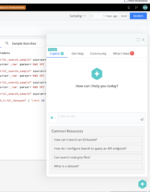
No matter what industry, company size or location, effectively managing and using data makes a business more competitive. Historically, as data needs have grown, the market introduced data warehouses to address evolving data storage needs. These data warehouses offered the ability to store vast amounts of data and deliver results quickly at a scale that traditional databases couldn’t match. They also introduced expensive hardware costs, inflexible capacity, difficulty integrating data and tedious setup requirements. Today, businesses are looking to switch up their data warehouse strategy to something that offers the original promise without the compromises.
Companies are able to deliver more data, faster and easier, by shifting to a cloud data warehouse. According to the Cloud Data Warehouse Trends Report 2019, 81% of the organizations surveyed rate the complexity of their on-premise data warehouse as “difficult” or “very difficult.” This is because they don’t offer the scalability and cost savings of cloud data warehouses. The cloud has fundamentally changed the infrastructure, cost and performance aspects of data warehousing, but unfortunately, cloud data warehousing hasn’t solved the inherent issues with the data itself – ensuring it’s usable and trustworthy.
Cloud data warehouses don’t solve all your issues
We exist in a complex data landscape currently. Data is on-premise and in the cloud and constantly being exchanged with customers, partners, employees and suppliers (not to mention all the new data sources creating a daily deluge). It’s organized in different formats across different protocols coming at different speeds with little standardization, consistency or quality from one source to another. This can create an architecture that scales beyond your control.
Many organizations, when making the transition from traditional data warehouses to cloud data warehouses, think these problems will go away. But that’s not the case. Cloud data warehouses provide instant access to hardware resources, allowing you to scale at cost and only pay for what you use, but they don’t solve issues with the data itself. Data governance and integration are still necessary – now more than ever.
The goal is to execute quickly and ingest data efficiently, but it’s still necessary to process, cleanse and govern data before placing it in the cloud data warehouse so you can actually use it. Many organizations run into a build vs. buy issue here. It’s expensive to build an ad-hoc solution to this data integration and quality issue, but you don’t have to build it yourself. Cloud data warehouses allow you to easily couple best-of-breed cloud integration Platforms as a Service (iPaaS) solutions to their ecosystems, so you can get the full value from your data programs in a cloud-first world.
Getting the most out of your cloud data warehouse use cases
Cloud data warehouses give organizations so much flexibility, and yet they often limit themselves to just one use case – analytics. If you’re able to integrate all types of data – from enterprise apps and mobile, to the lab, to APIs and IoT – in a consistent and governed way, you can leverage other use cases like machine learning or customer-driven experiences easily. All of this is built on the foundation of actionable and trusted data. As you add more data sources and build trust and governance and integrate between them, there is no limit to what you can do.
A good data integration solution will have hundreds of connectors and components that make it simple to connect any application or source of data that you need or use – in the cloud, on premise or both. A modern approach to data warehousing, with a robust integration solution alongside it, allows an organization to broaden its horizons and think about tying together things they might not have even considered possible to integrate, taking advantage of their complete data infrastructure.
For example, Decision Resources Group (DRG) manages comprehensive data repositories covering more than 90% of the U.S. healthcare system. DRG was struggling to combine and organize their disparate data sources. Because healthcare data is stored in a structured way, DRG needed to clean and normalize millions of records and group data to assess patient needs and market conditions. The company implemented a cloud data warehouse together with an iPaaS solution as the foundation of its new Real World Data Platform and became 150% more productive without increasing costs, and successfully onboarded 100 terabytes of data in just three months. DRG can now supply more meaningful data enabling physicians to understand different patient populations and provider markets to interact with them in a more optimized fashion.
Cloud data warehouses are uniquely poised as key repositories for digital transformation. Their innate value is driven by their data, but the data must be comprehensive, trustworthy and consumable. Optimizing a cloud data warehouse can be challenging, but the best solution doesn’t have to be complicated. Data integration tools need to be as nimble as the systems they are integrating. Leveraging future-proof architecture means you’ll always be in line with current technology trends, giving you peace of mind that today’s solutions won’t become tomorrow’s problems.








